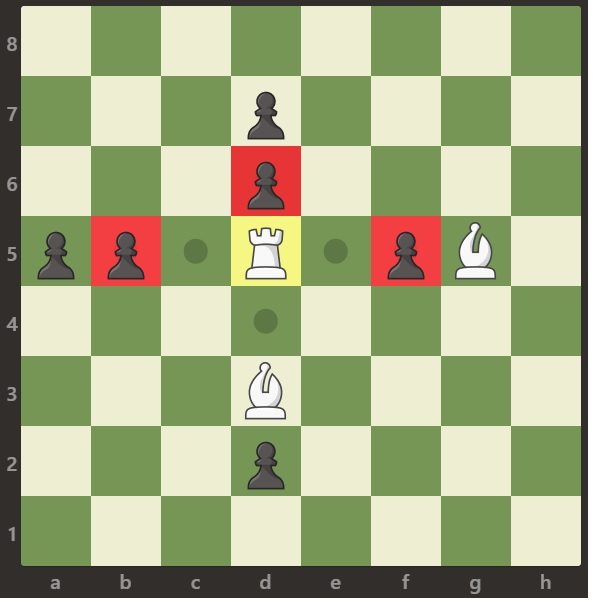On an 8 x 8 chessboard, there is one white rook. There also may be empty squares, white bishops, and black pawns. These are given as characters ‘R’, ‘.’, ‘B’, and ‘p’ respectively. Uppercase characters represent white pieces, and lowercase characters represent black pieces.
The rook moves as in the rules of Chess: it chooses one of four cardinal directions (north, east, west, and south), then moves in that direction until it chooses to stop, reaches the edge of the board, or captures an opposite colored pawn by moving to the same square it occupies. Also, rooks cannot move into the same square as other friendly bishops.
Return the number of pawns the rook can capture in one move.
Example 1:
Input: [[".",".",".",".",".",".",".","."],[".",".",".","p",".",".",".","."],[".",".",".","R",".",".",".","p"],[".",".",".",".",".",".",".","."],[".",".",".",".",".",".",".","."],[".",".",".","p",".",".",".","."],[".",".",".",".",".",".",".","."],[".",".",".",".",".",".",".","."]]Output: 3
Explanation:
In this example the rook is able to capture all the pawns.Example 2:
Input: [[".",".",".",".",".",".",".","."],[".","p","p","p","p","p",".","."],[".","p","p","B","p","p",".","."],[".","p","B","R","B","p",".","."],[".","p","p","B","p","p",".","."],[".","p","p","p","p","p",".","."],[".",".",".",".",".",".",".","."],[".",".",".",".",".",".",".","."]]Output: 0
Explanation:
Bishops are blocking the rook to capture any pawn.Example 3:
Input: [[".",".",".",".",".",".",".","."],[".",".",".","p",".",".",".","."],[".",".",".","p",".",".",".","."],["p","p",".","R",".","p","B","."],[".",".",".",".",".",".",".","."],[".",".",".","B",".",".",".","."],[".",".",".","p",".",".",".","."],[".",".",".",".",".",".",".","."]]Output: 3
Explanation:
The rook can capture the pawns at positions b5, d6 and f5.board.length == board[i].length == 8
board[i][j] is either ‘R’, ‘.’, ‘B’, or ‘p’
There is exactly one cell with board[i][j] == ‘R’
Chess Algorithm to compute Available Caputres for Rook in C++
The algorithm is straightforward: iterate each pixel on the chess board which is constant 8×8, as there is only one rook, we can break if we found it.
When we have the position of the Rook, we can move the Rook at four directions (straight and break if the rook meets Bishop, increment the counter if the rook meets a prawn).
1 2 3 4 5 6 7 8 9 10 11 12 13 14 15 16 17 18 19 20 21 22 23 24 25 26 27 28 29 30 31 32 33 34 35 36 37 38 | class Solution { public: int numRookCaptures(vector<vector<char>>& board) { int ans = 0; for (int i = 0; i < 8; ++ i) { for (int j = 0; j < 8; ++ j) { if (board[i][j] == 'R') { // found the ROOK for (int x = i + 1; x < 8 && (board[x][j] != 'B'); ++ x) { if (board[x][j] == 'p') { ans ++; break; } } for (int x = i - 1; x >= 0 && (board[x][j] != 'B'); -- x) { if (board[x][j] == 'p') { ans ++; break; } } for (int x = j + 1; x < 8 && (board[i][x] != 'B'); ++ x) { if (board[i][x] == 'p') { ans ++; break; } } for (int x = j - 1; x >= 0 && (board[i][x] != 'B'); -- x) { if (board[i][x] == 'p') { ans ++; break; } } break; // as there is only 1 Rook. } } } return ans; } }; |
class Solution {
public:
int numRookCaptures(vector<vector<char>>& board) {
int ans = 0;
for (int i = 0; i < 8; ++ i) {
for (int j = 0; j < 8; ++ j) {
if (board[i][j] == 'R') { // found the ROOK
for (int x = i + 1; x < 8 && (board[x][j] != 'B'); ++ x) {
if (board[x][j] == 'p') {
ans ++;
break;
}
}
for (int x = i - 1; x >= 0 && (board[x][j] != 'B'); -- x) {
if (board[x][j] == 'p') {
ans ++;
break;
}
}
for (int x = j + 1; x < 8 && (board[i][x] != 'B'); ++ x) {
if (board[i][x] == 'p') {
ans ++;
break;
}
}
for (int x = j - 1; x >= 0 && (board[i][x] != 'B'); -- x) {
if (board[i][x] == 'p') {
ans ++;
break;
}
}
break; // as there is only 1 Rook.
}
}
}
return ans;
}
};Both time and space complexity is O(1).
–EOF (The Ultimate Computing & Technology Blog) —
loading...
Last Post: Build Your First Node.JS Unikernel with OPS
Next Post: How to Construct Binary Search Tree from Preorder Traversal? (C++ and Java)


